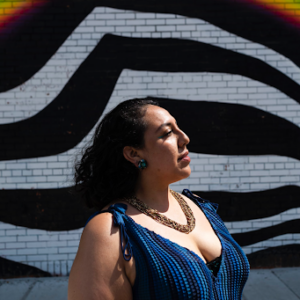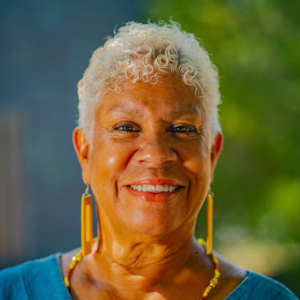
Honoring the Living Black Archive was a conversation between archivists examining and working to preserve and sustain the legacy of communities and cultural memory via the living black archive. Our Black history/futures program began with a presentation paying homage to Hiram Maristany (1945-2022), a most prolific and renowned Afro-Nuyorican photographer, documentarian, and activist revered and respected for capturing the multifaceted lives of Puerto Ricans in East Harlem for over sixty years.
The discussion was moderated by En Foco’s Curator-at-Large, Tarisse Iriarte, and Melody Capote (Executive Director CCCADI) who is a long time friend of the late Maristany, she was joined by Chayanne Marcano (Independent Researcher), and Stephanie Alvarado (Archivist/Memory worker/Activist).
Our esteemed panelists were in conversation, detailing their archival practice and approaches to historical archiving, preservation and digitization. Their work amplifies how the Black archive aims to propel communities forward during a time of rapid cultural displacement. Panelists discussed how communities throughout New York City are turning to archives as a tool for activism and to memorialize relationships. The conversation focused on how black archives bring together communities from across the diaspora who share similar and distinct histories of struggle, joy and radical imagination
Hiram Sebastian Maristany was born in Manhattan to Reinaldo and Margarita Maristany, who migrated to New York from Puerto Rico. In his early teens, Maristany picked up a camera at the suggestion of social worker Dan Murrow, beginning the sixty plus year documentation of his East Harlem community, also known as Spanish Harlem or El Barrio.
In the late 1960s Maristany was a part of an antipoverty program called the Photography Workshop, funded by the Social Research Center at Columbia University’s Teachers College. He was an active member in his community and through this program Maristany met other young activists, including future Young Lords members. At the founding of the New York Chapter of the Young Lords, later known as the Young Lords Party, Maristany was one of the original members and their official photographer.
Maristany participated in and documented the political activism of the Young Lords Party, including the Garbage Offensive and the occupation of the First Spanish United Methodist Church. He was also committed to other forms of community activism, including helping artist Raphael Montañez Ortiz establish a museum for and by the community: El Museo del Barrio. By 1971, Maristany was organizing educational activities, exhibitions, programs, and workshops for the museum. Later that year, he along with Marta Moreno Vega, Eugene Calderón, and Hilda Arroyo became the initial directors for “Amigos del Museo del Barrio.” Four years later, Maristany was named the Acting Assistant Director, and, from April 1975 to 1977, served as the museum’s Acting Director.
Throughout his life Maristany was an integral member of the Nuyorican movement and grew to become one of the “most prolific and consequential Latinx photographers of the latter half of the 20th century.” He documented the everyday life of the East Harlem community, the joys and hardships, the discrimination, self-determination, dignity, and resilience. He remained active in the Puerto Rican and larger Latinx movements as a mentor to artists including Miguel Luciano.
Hiram Maristany called his photography part history and part documentary, but most importantly, a way to uphold cultural identity. He is remembered as the people’s photographer of El Barrio, the community he loved, where he was a lifelong resident until his death in 2022.
Special thanks to the Smithsonian National Museum of African American History and Culture, The Mapping Resistance Project, The Maristany Family and Estate, and Miguel Luciano for access to the materials necessary to highlight the artwork and legacy of Hiram Maristany.

Stephanie Alvarado is a queer gender nonbinary disabled femme antidisciplinary artist, poet, archivist, photographer, facilitator and cultural organizer for 20 years. Stephanie was born and raised in the Bronx, NY by way of Guayaquil, Ecuador. They alchemize photography, feminist performance, community based photo archiving, and political education into community building and social justice practices in public spaces for people of color. Their work is rooted in spiritual community healing, social justice, and local memory. They host intergenerational photo archiving teach-ins on public park land and community gardens to reclaim public space as cultural reparations for Black, Brown, and Indigenous communities.

Chayanne Marcano is an artist and writer born and raised in The Bronx, New York. Her research interests include space, place, and belonging. Currently, she is the Associate Producer at the interdisciplinary arts institution Abrons Arts Center in New York City’s Lower East Side. She has supported archival research for projects with The Metropolitan Museum of Art and the Association of African American Life and History.

Melody Capote was appointed executive director of CCCADI in 2018. She began her long tenure at the organization in 1984 and throughout the years has established herself as a leader in arts administration and cultural activism. She is a vocal and bold voice in advocating for cultural equity, racial and social justice for African descendant communities.

Tarisse Iriarte is an independent curator and arts activist from Brooklyn with Afro Caribbean Roots in Cuba and Puerto Rico. She is simply known as “Tee” in her beloved Communities. Tee is what happens when a human loves art, the earth, and justice. She is a proud Afro-Puerto Rican working diligently on the global liberation of her people across the diaspora through socially- engaged art. Tee curates exhibits that contextualize the intersections of diasporan arts across a socio-political landscape and works tirelessly to sow seeds rooted in liberatory praxis alongside a global community of artists, movement workers, and radical thinkers. Tee serves on the advisory board for ARTE (Art Resistance Through Education) and is a member of NALAC (National Association of Latino Arts & Culture) AAMC (Association of Art Museum Curators) and the Katal Center for Health Equity and Justice
About En Foco | En Foco, Inc. is a non-profit that supports U.S.-based photographers of African, Asian, Latino, Native American, and Pacific Islander heritage. Founded in 1974, En Foco makes their work visible to the art world, yet remains accessible to under-served communities. Through exhibitions, workshops, events, and publications, it provides professional recognition, honoraria, and assistance to photographers as they grow into different stages of their careers. For more information, please visit: enfoco.org.
About the Caribbean Cultural Center African Diaspora Institute | The Caribbean Cultural Center African Diaspora Institute is an arts, culture, education and media organization that advances cultural equity, racial and social justice for African descendant communities. CCCADI’s programs serve children/youth, families, young professionals, elders, local and international artists, and practitioners of African-based spiritual traditions. Through our work CCCADI offers a collective space where African descendants honor the contributions of the global African Diaspora through exhibitions, performances, conferences, educational programs, and international exchanges. For more information, please visit: cccadi.org.
Honoring the Living Black Archive:
Presentation
Smithsonian National Museum of African American History & Culture:
https://nmaahc.si.edu/latinx/hiram-maristany
NY Latin Culture Magazine:
https://www.newyorklatinculture.com/cccadi/
World Cat:
https://www.worldcat.org
Getty Provenance Index:
https://www.getty.edu/research/tools/provenance/search.html
Fotos y Recuerdos Archiving Toolkit:
https://www.stephaniealvarado.com/fotos-y-recuerdos
Schomburg Center Digital Collection:
https://www.nypl.org/about/locations/schomburg/digital-schomburg
Archiving Black Culture: Artists, Community, and Alternative Archival Practices:
https://vimeo.com/615995817
Nomadic Archival Project (NAP):
https://www.nomadicarchivistsproject.com
Black Archives:
www.blackarchives.co
Archiving the Black Web:
https://archivingtheblackweb.org
En Foco is supported in part with public funds from the New York City Department of Cultural Affairs, in partnership with the City Council, National Endowment for the Arts, New York State Council on the Arts with the support of Governor Kathy Hochul and the New York State Legislature, The Mellon Foundation, BronxCare Health System, The Joy of Giving Something, Inc., Rockefeller Brothers Fund Culpeper Arts and Culture, New York Community Trust Mosaic Network & Fund, the Phillip and Edith Leonian Foundation, Ford Foundation, The Lily Auchincloss Foundation, Mertz Gilmore Foundation, Jerome Foundation, The Hispanic Federation and Aguado-Pavlick Arts Fund.
Special thanks to the Smithsonian National Museum of African American History and Culture, The Mapping Resistance Project, The Maristany Family and Estate, and Miguel Luciano for access to the materials necessary to highlight the artwork and legacy of Hiram Maristany.

© 2025 En Foco, Inc. | All Rights Reserved
En Foco, Inc.
15 Canal Place
Bronx, NY 10451
Email: [email protected]
Call: (917) 503-8017